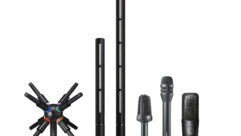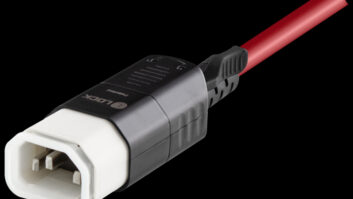
Independent artist, composer and lecturer, Daniel Blinkhorn, has been using DPA microphones in a variety of ingenious ways to capture the sound of some of the planet’s most important habitats.
Blinkhorn spent over a month travelling through Africa’s myriad soundscapes and chose to use DPA’s d:dictate™ 4006A Omnidirectional Microphones – legendary recording classics, which were recommended and supplied by DPA’s Australian Distributor Amber Technology. His background is in recording sound for creative compositions, as well as archival and eco-acoustic resources. As Blinkhorn explains, this entails ‘creative works of all kinds, using instruments, sound installations, film sound, fixed-media and acousmatic music, and plenty of sound design’. For this project, he recorded in the field in Tanzania, Kenya, Rwanda, Zanzibar and the Côte d’Ivoire.
Daniel Blinkhorn’s African adventure was a one-off and he knew from the outset that he wouldn’t have a chance to re-visit many of the places on his itinerary. Therefore, he was very careful when it came to choosing his portable recording rig, especially in his choice of microphones.
“A key reason why I chose DPA microphones was familiarity,” he explains. “Not only had I used them in places throughout Svalbard in the winter time, Alaska and Australia at the height of summer (really putting their ability to function in extreme heat and cold to the test), but I knew that many of the places I would be visiting encompassed expansive distances. This made the choice of microphone even more critical. With the DPA 4006A’s I could take full advantage of the lower frequency capacities on offer when recording from further afield, plus their legendary ability to offer uncompromising high frequency sound capturing meant they were also ideal when I was closer to the subject matter.
“The d:dicate™ 4006A omnis are renowned for their precision and brought quite a bit more to the table. Precision is very important to me when I’m recording in the field as I am attempting to capture all manner of nuance, depth and gradation of sound. Neutrality is also important and the DPAs provided a clean, responsive, highly articulate, zero coloration to the field recordings. Natural acquisition of materials is paramount, and the mics performed faultlessly in a variety of complex auditory environments.”
As is usual for recording on the fly, Blinkhorn often needed to record at a moment’s notice. His creative solution was to modify a blimp and house the microphones securely inside its casing in a stereo configuration.
After a little finessing and wrangling of the original blimp, I was able to attain a symmetrically balanced equilibrium between the two omnis in an attempt to capture as complete an audible image as possible,” he explains. “It really did assist in an easier and smoother workflow, but as I do most of my work in surround sound, I also intend to start using DPA’s d:mension™ 5100 Mobile Surround Microphone because I believe it will augment this compact rig and enable myriad configurable possibilities: most importantly, surround recording.”
Blinkhorn also experimented with mic placement, at times using a single omni and other techniques. “Given the expansive, extreme and varied audible materials in the left and right axis in many of the places I was recording (Maasai villages, open savannah, dense jungle), practicality and versatility were key – dismantling the rig quickly and easily was a major and time-consuming consideration.
“One of the most impressive aspects of the DPA microphones was how adaptive they were to audible diversity. They captured the smallest nuance of animal sounds, yet also were incredibly well suited to acquiring people and cityscape ambience. As long as I kept a close eye on monitoring signals for unexpected transient and harsher industrial sounds, the d:dicate™ 4006As captured every nuance of sonic environment across such a wide range, very effectively.”
Blinkhorn adds that the 4006A microphones overcame almost every issue he had encountered when using other manufacturers’ equipment.
“Previously when I have recorded in the field on (allegedly) high quality microphones, I have faced numerous issues with durability and cheap componentry within the manufacturing process,” he says. “Suffice to say this has had a negative impact on the final recordings. Some of these issues included extreme self-noise, internal (XLR) pins bending and snapping, power switches malfunctioning, phantom power completely failing, cracked casing, thread stripping on grilles and even inexplicable frequency response omission (in the mid ranges of all places!) on certain microphones. Thankfully, none of these problems arose with the d:dicate™ 4006A microphones. They may not originally have been designed for field recording purposes, but they work beautifully within that context.
“Also, as opposed to studio-based recording where very careful consideration must be given to avoiding ‘leakage’, recording in the field makes you very accepting of leakage – indeed, it can even be desirable. I found the full gambit of sound could be captured flawlessly thanks to the quality of the 4006A’s and their remarkable omnidirectional design.”
For Blinkhorn, the crux of his work lies in using sound to tell the story of preserving natural African habitats and the creatures reliant on them. He describes his compositional language as ‘a cross-pollination of instrumental, electroacoustic and videophonic music, all drawing from environmental sound’. His aim is to give audiences the chance to ‘contemplate the diversity and extreme sensitivities of habitats, coupled with the need to better understand our roles as custodians’.
Blinkhorn’s most recent audio release is frostbYte, a suite of four tracks ranging from MP3 to 5.1 surround sound, on UK label AudioBulb. As a composer, Blinkhorn has won over 25 international awards for work based on environmental/ecoacoustic music and field recordings. He is also a 2011 Churchill Fellow who has worked in a variety of creative, academic, research and performative contexts, and is the representative member for composition at Music Australia. He has been a visiting scholar at the University of Virginia Music Department, the Conservatory of Music, University of Kansas City Missouri, Simon Fraser University, Vancouver and faculty member for Ecosono Alaska, a joint initiative between Ecosono Institute and Alaska Pacific University.
For more information on Blinkhorn and his work, please visit www.danielblinkhorn.com
-ends-
About DPA Microphones
At DPA Microphones we’re passionate about acoustic truth. That’s why every DPA microphone combines ingenious audio engineering with brilliant design and is crafted with more than 200 hands-on procedures at our own facilities in Denmark: to get as close as humanly possible to honest sound.
For more information, please visit www.dpamicrophones.com










